How To Leash Train A Kitten for Outdoor Walks? 5 Easy Steps
Dogs are not the only domesticated pets that can walk on a leash; cats can, too! However, the approach on how to leash train a kitten is different from dogs.
You need to get the right harness and start slowly indoors. Getting your cat used to the restraint and the feeling of the leash is necessary, so it won’t try to take it off.
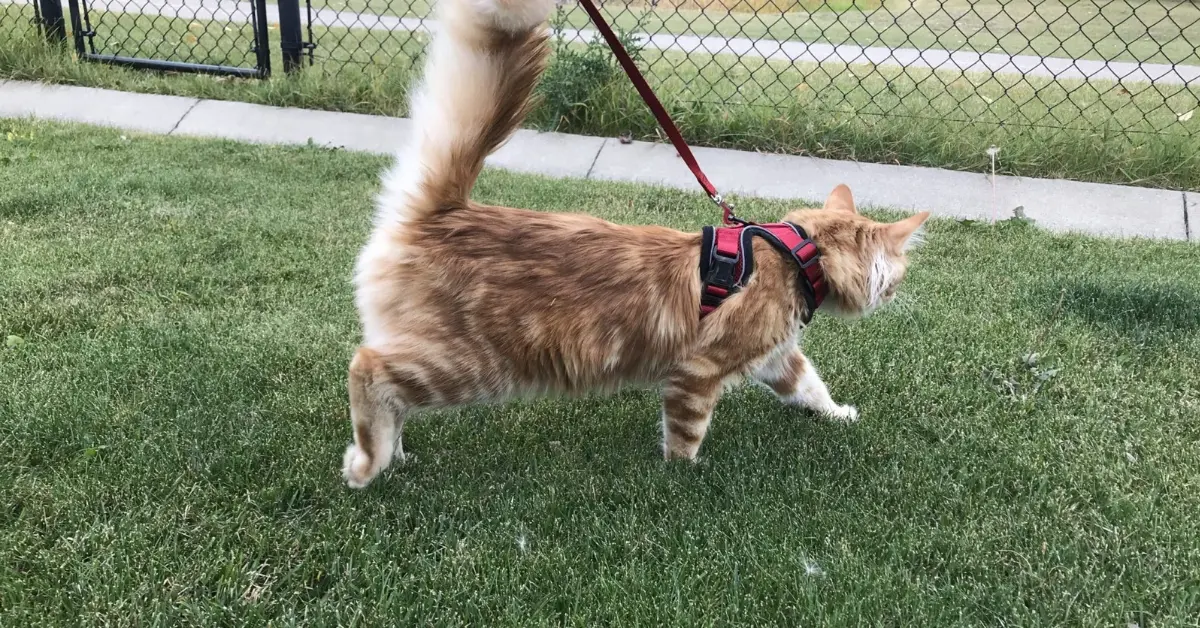
You have to be patient because, unlike canines, most cats will need time to get used to being on a leash.
For a more detailed process, here’s my quick guide:
How To Leash Train A Kitten for Outdoor Walks? 5 Easy Steps
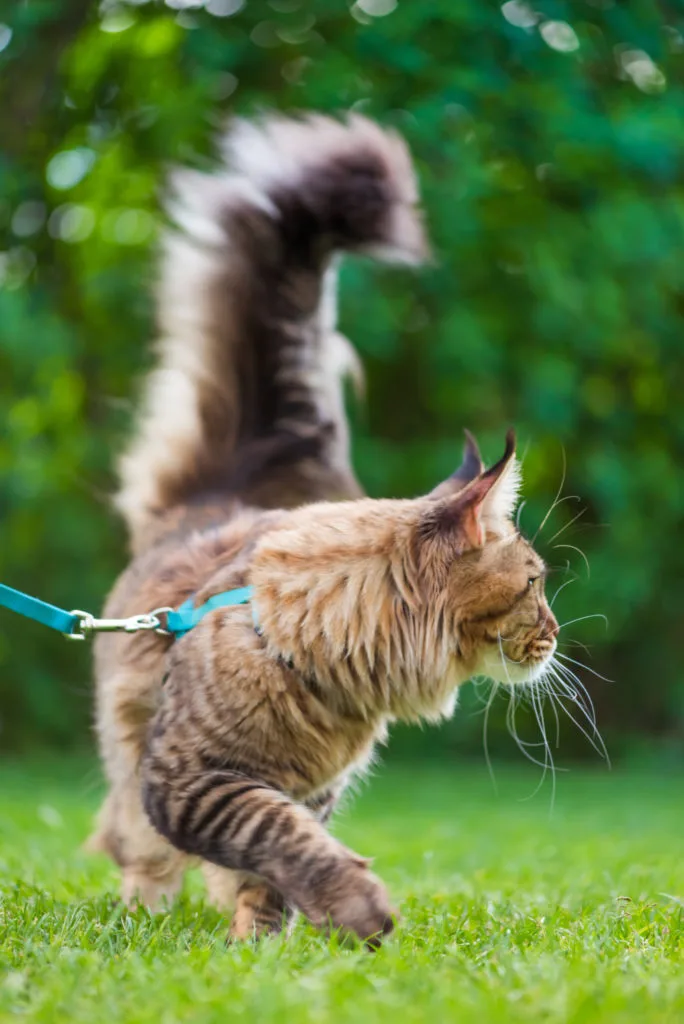
-
Step 1. Get the right harness
The first step in leash training a kitten is to get the right harness. Take note that you shouldn’t use a small dog’s harness because it’s not suitable for kittens’ physical characteristics.
You should get a properly fitted cat harness, made of lightweight fabric or nylon. Also, never use chains or Flexi-type leashes on kittens. Unlike canines, kittens have softer bodies that can get hurt easily by a strong tug.
Aside from that, the leash attachment should be located behind the harness and not on your kitten’s neck. Unlike dogs, there’s no need to tug a kitten away since they are not as strong as dogs.
-
Step 2. Let your cat be familiar with it
Once you have the right gear, it’s time to introduce it to your kitten. When leash training a feline, never put the leash or harness right away. Just show it to your cat and let it sniff around.
You’d want your kitty to become familiar and relaxed in the presence of the harness and leash. They have to know that such items are not threatening.
I suggest giving treats as you show the leash. This will allow your kitten to associate leash training with a positive experience.
Put the harness on the floor and sprinkle some kibble on it. Once your kitten is done eating the treats, give it a nice pet and affection. Please read here: How Long Should Kittens Eat Kitten Food
Once your kitten is relaxed, you can try bringing the harness closer to its body. If the kitten steps back, take the harness away and repeat. This time, give a treat as you get the harness close.
Soon enough, you can clip the harness on, and your kitten won’t even notice.
-
Step 3. Let the cat drag the leash
Once your kitten has acclimated to the harness, the next step is to put the leash on. However, you should not apply tension just yet.
Let your kitten drag the leash around. You may also notice your cat playing with it. However, make sure that you are there to supervise the kitty as the leash may wrap around their bodies or get tangled on furniture.
Remember that cats prefer doing things at their own pace. You should let your kitten walk around the house with the harness and leash on until they are fully comfortable.
Never rush leash training, or your cat may start to loathe it.
-
Step 4. Start leading
Once your kitten is used to the leash and harness, you can pick up the leash and start leading. Keep the leash loose and follow where your cat goes. Give your cat some treats as you hold the leash.
Slowly, you can add a little tension to the leash but never pull it. Coax your cat to where you want it to walk while tightening the leash slightly. Use a persistent tension but not a jerking motion.
If the cat goes in the direction that you want, give it a treat right away.
Do this around the house, on stairs, doors, and hallways. As much as possible, you’d want your kitten to master leash training indoors since there are minimal distractions.
-
Step 5. Try it outside
If you think that your cat is properly leash trained indoors, it’s time to venture outdoors. Start on a small part of your yard where you will let your kitten sniff and walk around.
Make sure that you’re not pulling or applying too much tension on the leash.
Outdoors, you should allow your kitten to explore around. However, never force it to go someplace where it’s not comfortable.
If you have to stick to the 6-feet stretch of your driveway, then do so. You have more time later on to expand the reach of your kitten.
Each day, encourage your cat to walk further by coaxing with treats. Still, let the kitty retreat back to its comfort zone whenever it wants to. Again, keep a mild tension on the leash at all times.
Remember that kittens are not puppies. You can’t expect them to rush to the sidewalk right away or be ready for a walk in the neighborhood.
Kittens that are reared mostly inside the house will be afraid of the vast space outdoors. Take it one day at a time and follow your kitten’s phase during leash training.
Benefits of leash training a kitten
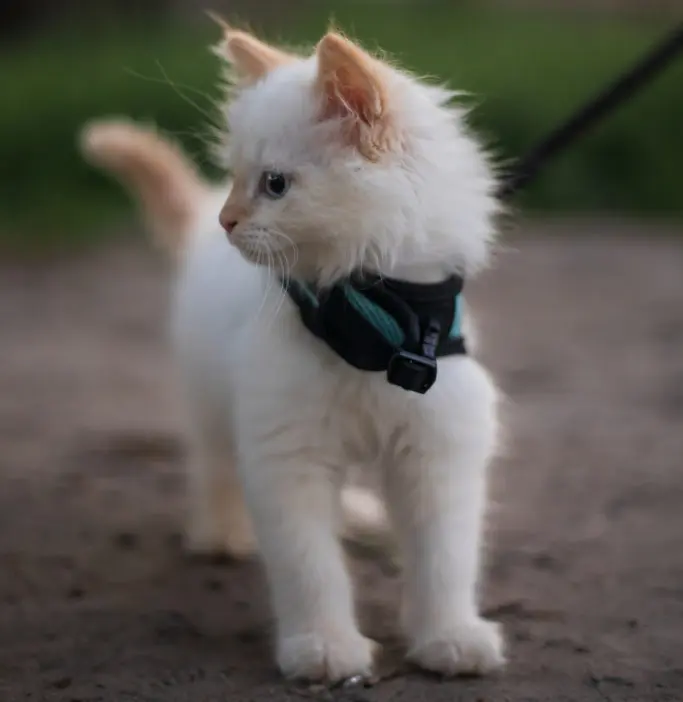
While leash training is popular for dogs, leashing a kitten has its perks too. The following are some of the benefits of getting your kitty used to the restraint:
-
Control
Cats are notorious climbers, which can be a problem if you’re taking them outdoors. The kitten might get stuck on top of a tree or get lost when you’re not looking.
-
Fun
Indoor cats that are not socialized or exposed to outdoor stimuli will be nervous and aloof.
To raise a well-rounded kitten, it’s best to train them to walk on a leash. In the long run, your kitten will love the experience.
-
Exercise
Kittens can gain excess weight if they don’t get enough exercise. Leash training will help the kitten take a stroll outdoors safely.
It’s a great addition to your kitten’s activities instead of leaving your cat alone in the house for too long while you are out.
- Safety
Your kitten may have zoomies outdoors, which will be dangerous if it happens near a road. Also, there might be other animals around that your kitten may chase.
When should I start leash training my kitten?
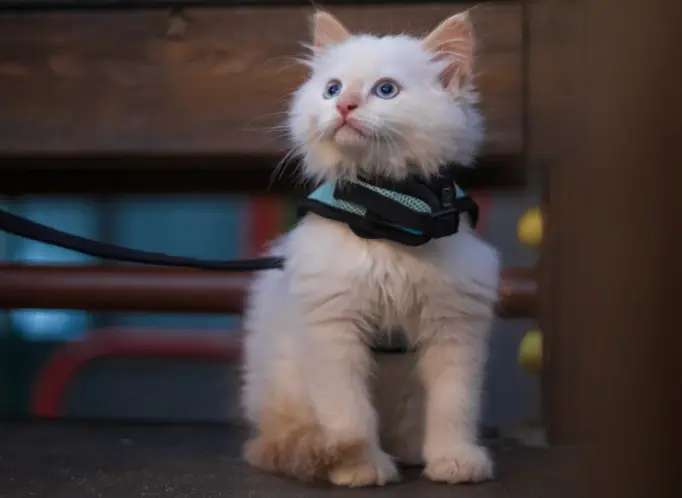
You can start leash training your kitten once it reaches 16 weeks old. However, you should keep the training indoors as very young kittens are prone to injuries.
Also, you should change the kitten’s harness after a few months as its body grows.
You can start going outdoors with your leash-trained kitten at around 6 to 7 months.
Try to keep the trips short and within your yard to avoid overstimulation on your kitten’s part. As much as possible, you should wait for your cat to grow past the tender age before walking them out of the yard.
How Long Will My Cat Take To Be Leash-trained?
Leash training a cat is easier but training a kitten will take longer.
Kittens may take several weeks or even months to adjust to leash. To get quick results you need to be consistent in training your kitten.
Young and energetic cats may take only a few days to get comfortable with leash and harness.
Cat Breeds You Can Walk On A Leash
All kittens can be leashed trained. However, some breeds are more accepting, while others are not. Usually, you will struggle with cat breeds with intense prey drive.
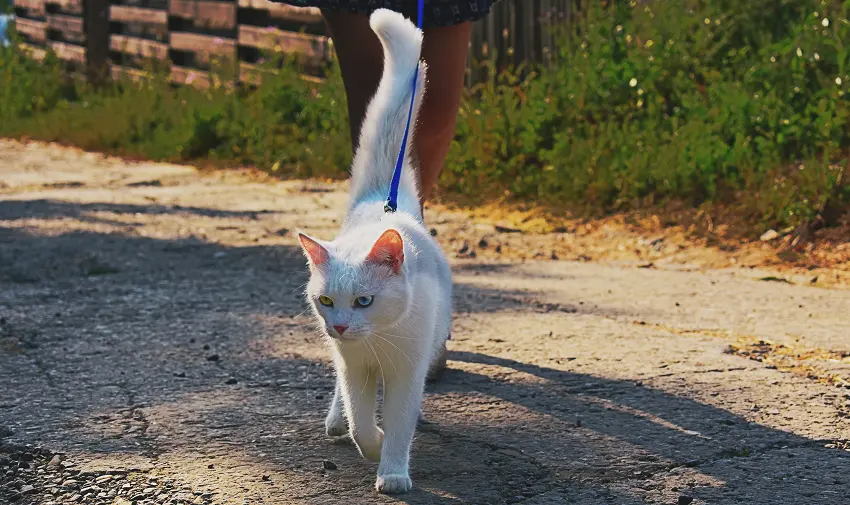
But if you’re looking for cat breeds that you can walk on a leash, the following are some of the topnotch breeds:
-
Ragdoll
Ragdolls are known to be one of the cuddliest and most gentle breeds.
They also love walking on a leash with their humans. Still, they are best walked on enclosed gardens as they can be too soft-natured.
-
Burmese
This breed is a curious cat and will do well on leashed walks. You must start them young for higher success rates.
-
Maine Coon
As a large breed, Maine Coons are best leashed when being taken outdoors.
They love having fun, and one way to do this is to walk on a leash.
-
British Shorthair
This cat breed isn’t the most energetic, which is an advantage during leash training. They prefer looking around and observing.
Conclusion
Knowing how to leash train a kitten starts by getting the properly fitted cat harness (I bought it on Amazon and it’s very good).
You should start slow and allow your cat to go its own way. Always keep the leash loose to prevent hurting your kitten. Over time, your pet will learn to walk on a lead and explore larger areas.
We hope the information from this article will help make walks with your cat more safe and more fun. Thank you for reading!
